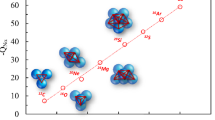Abstract
The new approach to the interpretation of the process of spontaneous fission of heavy nuclei is suggested. It is based on nuclear physics data which are obtained in heavy ion collisions. The process of spontaneous fission consists of three sequential stages: clusterization of the valent nucleons of a heavy nucleus into a light nucleus-cluster, which leads to the formation of a dinuclear system; evolution of the dinuclear system which proceeds by nucleon transfer from the heavy to light nucleus and decay of the dinuclear system from the equilibrium configuration into two fragments.
Similar content being viewed by others
References
N. Bohr and J. A. Wheeler, “The mechanism of nuclear fission,” Phys. Rev. 56, 426 (1939).
G. Gamov, “Quantum theory of the atomic nucleus,” Z. Phys. 51, 204 (1928).
K. A. Petrazhak and G. N. Flerov, “Spontaneous fission of uranium,” Zh. Eksp. Teor. Fiz. 10, 1013 (1940).
N. E. Holden and D. C. Hoffman, “Spontaneous fission half-lives for ground-state nuclides,” Pure Appl. Chem. 72, 1525–1652 (2000).
C. Wagemans, “Spontaneous fission,” in The Nuclear Fission Process, Ed. by C. Wagemans (CRC, Boca Raton, Ann Arbor, Boston, London, 1991), pp. 35–43.
E. Almqvist, D. A. Bromley, and J. A. Kuchner, “A new interpretation of cluster radioactivity mechanism,” Phys. Rev. Lett. 4, 515 (1960).
V. V. Vokov, “Deep inelastic transfer reactions the new type of reactions between complex nuclei,” Phys. Rep. 44, 93–157 (1978).
W. V. Schroder and J. R. Huizenga, in Treatise on Heavy-Ion Science, Ed. by D. A. Bromley (London, New York, 1984), Vol. 2, pp. 115–734.
V. V. Volkov and E. A. Cherepanov, “Formation of nuclear molecules in cluster radioactivity, on interpretation of the cluster radioactivity mechanism,” Phys. Part. Nucl. Lett. 10, 347–353 (2013).
Yu. S. Zamyatnin, V. L. Mikheev, S. P. Tretyakova, V. I. Furman, S. G. Kadmensky, and Yu. M. Tchuvil’sky, “Cluster radioactivity: achievements and perspectives,” Phys. Part. Nucl. 21, 537 (1990).
S. Raman, C. W. Nestor, and P. Tikkanen, “Transition probability from the ground to the first excited 2+ state of even-even nuclides,” At. Data Nucl. Data Tables 78, 1 (2001).
G. Audi, A. M. Wapstra, and C. Thibault, “The Ame2003 atomic mass evaluation. II. Tables, graphs and references,” Nucl. Phys. A 729, 337 (2003).
P. Möller et al., “Nuclear ground-state masses and deformations,” At. Data Nucl. Data Tables 59, 185 (1995).
C. Y. Wong, “Interaction barrier in charged-particle nuclear reactions,” Phys. Rev. Lett. 31, 12 (1973).
G. G. Adamian, N. V. Antonenko, R. V. Jolos, S. P. Ivanova, and O. I. Melnikova, “Potential energy of dinuclear system,” Int. J. Mod. Phys. E 5, 191 (1996).
A. B. Migdal, Theory of Finite Fermi System and Properties of Atomic Nuclei (Nauka, Moscow, 1983) [in Russian].
R. Bonetti, C. Chiesa, A. Guglielmetti, R. Matheoud, G. Poli, V. L. Mikheev, and S. P. Tretyakova, “First observation of spontaneous fission and search for cluster decay of 232Th,” Phys. Rev. C 51, 2530 (1995).
J. Randrup, E. E. Larsson, P. Möller, S. G. Nilsson, K. Pomorski, and A. Sobiczweski, “Spontaneous fission half-lives for even nuclei with Z≥92,” Phys. Rev. C 13, 229 (1976).
V. P. Zakharova, V. S. Zenkevich, and V. B. Funstein, “On the period of spontaneous fission of lead,” Phys. At. Nucl. 58, 709 (1995).
Author information
Authors and Affiliations
Corresponding author
Additional information
The article is published in the original.
Deceased.
Rights and permissions
About this article
Cite this article
Volkov, V.V., Cherepanov, E.A. & Kalandarov, S.A. Interpretation of the mechanism of spontaneous fission of heavy nuclei in the framework of dinuclear system conception. Phys. Part. Nuclei Lett. 13, 729–736 (2016). https://doi.org/10.1134/S1547477116060108
Received:
Published:
Issue Date:
DOI: https://doi.org/10.1134/S1547477116060108




